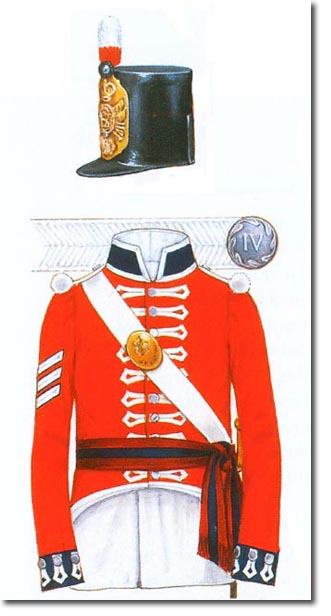|
|

 |
|
Men's coats, or jackets as they were now called, were described as red whereas officers and sergeants had scarlet so the colour was less rich for the men. The pewter buttons fastened from neck to waist with plain white lace decoration formed into bastion loops. The lace in 1742 and 1751 had a blue zig-zag pattern, changed to a single straight blue line in 1768 and although the non-royal regiments still had coloured lines in their lace, the Royal regiments like the King's Own had plain white. Detail of the lace and button is shown here.
The jacket was long waisted at this stage, but the tails were shorter than pre-1797 coats. In 1802, for the first time, the ranks for NCOs were indicated by chevrons sewn on the upper right arm. Up to the rank of sergeant they were plain white lace. For Warrant Officers the four chevrons were silver and the jackets more in the style of officers ie without lace. Sergeants also wore a sash round their waist, with a blue middle stripe (for Royal Regiments). Battalion companies had blue epaulettes edged in white and having white tufts. The Grenadier and Light compan1es had red wings attached to the end of the epaulette, edged with white tuft and striped with white lace. The shako was introduced in 1800 and made of stiff lacquered material which was not popular. In 1806 it was changed for a lighter felt material which was more comfortable but did not alter the appearance of the cap. The shako plate was of universal pattern for most regiments but was special for the 4th. See Shako Plate 1800. The plumes were as before for the bicorn hat, white over red for battalion companies, white for grenadiers, and green for light companies. Light companies also had a stringed bugle badge instead of the shako plate. Grenadiers had the shako for active service and marching but wore the bearskin cap for parades. Officers retained the bicorn hat until 1812. |
Armed Forces | Art and Culture | Articles | Biographies | Colonies | Discussion | Glossary | Home | Library | Links | Map Room | Sources and Media | Science and Technology | Search | Student Zone | Timelines | TV & Film | Wargames